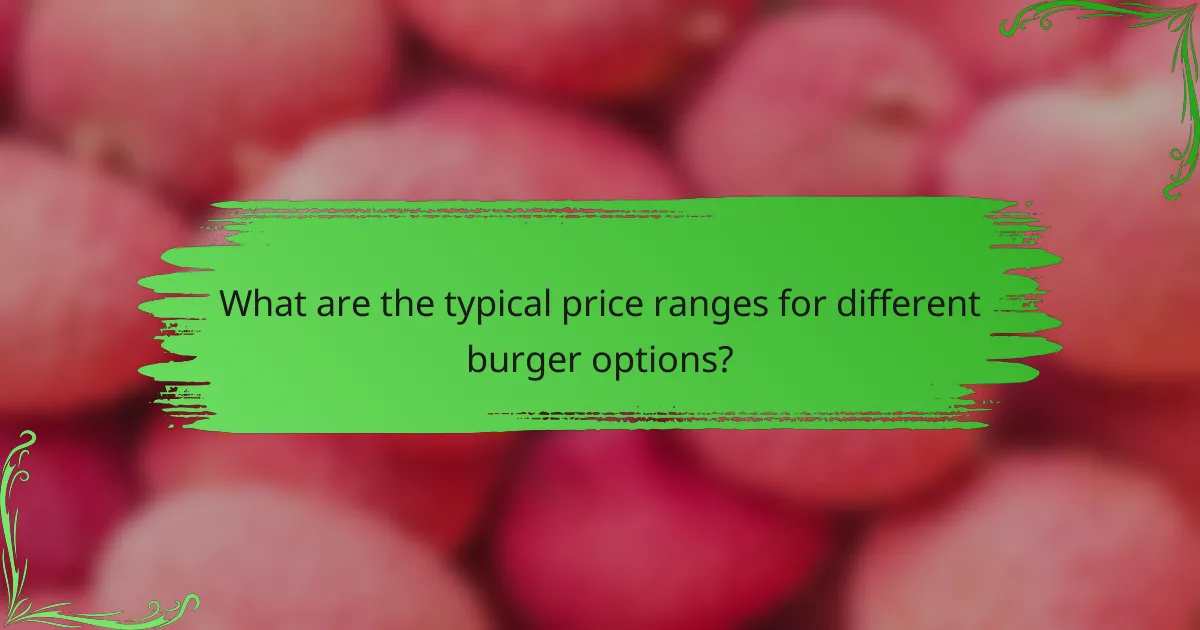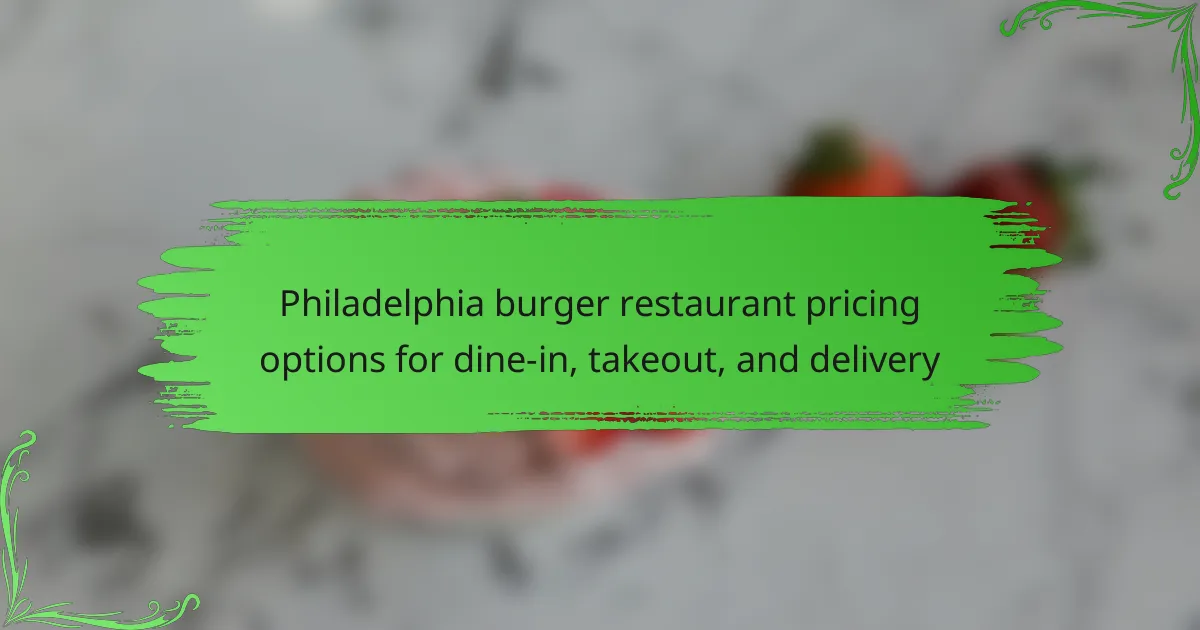Philadelphia burger restaurants provide diverse pricing options for dine-in, takeout, and delivery services. Dine-in prices typically range from $10 to $20 per burger, while takeout prices are similar, with combo deals available to reduce costs. Delivery prices can add $2 to $5 due to distance and fees. Fast food burgers are priced between $1 and $5, mid-range options between $10 and $15, and gourmet selections can exceed $25. To maximize value, diners can take advantage of happy hour specials, combo meals, and loyalty programs, as well as research menu options and look for online discounts.

What are the pricing options for Philadelphia burger restaurants?
Philadelphia burger restaurants offer a range of pricing options. Dine-in prices typically range from $10 to $20 per burger, depending on the restaurant’s style and ingredients. Takeout prices are generally similar, with some restaurants offering combo deals that may lower the overall cost. Delivery pricing can vary based on distance and delivery fees, which may add $2 to $5 to the total. Many establishments also offer specials or discounts on certain days, affecting pricing. Popular burger chains in Philadelphia may have value menus starting at around $5. Local gourmet burger spots can charge upwards of $15 for specialty burgers.
How do dine-in prices compare to takeout and delivery options?
Dine-in prices at Philadelphia burger restaurants are generally lower than takeout and delivery options. This price difference occurs due to added service fees and delivery costs associated with takeout and delivery. For example, many restaurants charge a premium for delivery services, which can increase the total cost by 10% to 20%. Additionally, takeout orders may include packaging fees that do not apply to dine-in experiences. Consequently, customers often find that dining in provides a more economical choice compared to ordering food to go or having it delivered.
What factors influence dine-in pricing at burger restaurants?
Dine-in pricing at burger restaurants is influenced by several factors. Ingredient quality significantly impacts the cost. Premium ingredients increase the overall price of dishes. Labor costs are another critical factor. Higher wages and staffing levels raise operational expenses. Location also plays a vital role. Restaurants in affluent areas often charge more for similar items. Menu variety can affect pricing as well. A diverse menu may lead to higher costs due to ingredient sourcing. Seasonal changes can influence prices too. Fluctuating ingredient costs during different seasons can affect menu pricing. Lastly, competition in the area can dictate pricing strategies. Restaurants may adjust prices based on nearby competitors to remain attractive.
Are there any additional costs associated with takeout and delivery?
Yes, there are additional costs associated with takeout and delivery. These costs can include service fees, delivery charges, and packaging fees. For example, many restaurants charge a delivery fee that can range from $2 to $10. Service fees may also apply, typically around 10% to 20% of the total order. Additionally, some establishments may charge for takeout packaging, especially for specialty items. These fees can vary widely based on the restaurant and the delivery service used.
What types of pricing models do Philadelphia burger restaurants use?
Philadelphia burger restaurants typically use a variety of pricing models. Common models include fixed pricing, where menu items have set prices. Dynamic pricing is also employed, adjusting prices based on demand or time of day. Value-based pricing is used, reflecting the perceived value of the burger experience. Additionally, bundle pricing is common, offering meal deals that combine burgers with sides and drinks at a discounted rate. Many restaurants also implement promotional pricing, such as discounts on specific days or during happy hours. These models cater to different customer preferences and maximize sales opportunities.
How do fixed pricing and dynamic pricing differ in this context?
Fixed pricing offers a consistent price for menu items regardless of demand or time, ensuring predictability for customers. In contrast, dynamic pricing adjusts prices based on demand fluctuations, time of day, or customer behavior, which can lead to higher prices during peak hours. For example, a burger might cost $10 during regular hours but increase to $12 during a busy dinner rush. This approach can optimize revenue by capitalizing on high demand periods. Many restaurants use dynamic pricing to manage inventory and maximize profits, as seen in various industry studies.
What are the common discounts or promotions available?
Common discounts and promotions available at Philadelphia burger restaurants include happy hour deals, student discounts, and loyalty programs. Happy hour typically offers reduced prices on selected menu items during specific hours. Student discounts often provide a percentage off the total bill for those with valid student identification. Loyalty programs reward repeat customers with points that can be redeemed for free items or discounts. Many restaurants also run seasonal promotions or limited-time offers to attract customers. These discounts can vary by location and may change frequently. Always check the restaurant’s website or social media for the latest promotions.

What are the typical price ranges for different burger options?
Typical price ranges for different burger options vary widely. Fast food burgers generally range from $1 to $5. Mid-range restaurant burgers typically cost between $10 and $15. Gourmet burgers can be priced from $15 to $25. Specialty or unique burgers may exceed $25. These prices reflect the quality of ingredients and preparation methods. In Philadelphia, local burger joints often align with these ranges. Prices may fluctuate based on location and demand.
How do gourmet burgers differ in pricing from standard options?
Gourmet burgers typically have higher prices than standard options. This price difference is due to several factors. Gourmet burgers often use premium ingredients. These may include high-quality meats, artisanal cheeses, and unique toppings. Standard burgers generally use more basic, mass-produced components. Gourmet options may also feature creative recipes and flavor combinations. Additionally, gourmet burgers are often served in upscale restaurant environments. This contributes to higher operational costs, which are reflected in the pricing. According to industry reports, gourmet burgers can be priced 20-50% higher than standard burgers in restaurants.
What are the average prices for vegetarian and vegan burger options?
The average prices for vegetarian and vegan burger options in Philadelphia typically range from $10 to $15. Many restaurants offer these options as part of their menu to cater to diverse dietary preferences. For instance, popular chains and local eateries often price their vegetarian burgers around $11. Vegan burgers usually fall within a similar price range, averaging about $12. These prices can vary based on ingredients and restaurant location. Specialty ingredients or gourmet options may increase prices slightly, sometimes reaching up to $18. Overall, the average price reflects the growing demand for plant-based alternatives in the burger market.
How do specialty toppings affect the overall cost?
Specialty toppings increase the overall cost of a burger. Each specialty topping typically adds a specific dollar amount to the base price. For instance, gourmet cheeses or unique sauces may range from $1 to $3 extra. The total cost rises with each additional topping chosen by the customer. This pricing strategy reflects the premium ingredients used. Customers seeking unique flavors often opt for these toppings. Consequently, the overall cost of the meal can significantly increase based on the selection of specialty toppings.
What additional costs should customers consider?
Customers should consider several additional costs when dining at a Philadelphia burger restaurant. These costs include taxes, which typically range from 6% to 8% of the total bill. Gratuity is another factor, often suggested at 15% to 20% for dine-in services. Delivery fees may apply, commonly between $3 to $7, depending on the distance. Takeout orders may incur packaging fees, which can vary by restaurant. Additionally, customers should be aware of potential surcharges for special requests or modifications to their orders. Finally, beverages and sides can significantly increase the overall cost, often adding $2 to $10 per item. Each of these factors contributes to the total expense of the dining experience.
Are there delivery fees associated with ordering from burger restaurants?
Yes, there are delivery fees associated with ordering from burger restaurants. These fees vary by restaurant and delivery service. Typically, fees can range from $2 to $10. Some burger restaurants may offer free delivery promotions. Delivery fees are often added to the total cost at checkout. Customers should check the specific restaurant’s delivery policy for exact fees. Many restaurants display these fees on their menus or websites. This transparency helps customers make informed choices before placing an order.
How do service charges impact the final bill for dine-in customers?
Service charges increase the final bill for dine-in customers. Typically, these charges range from 15% to 20% of the total bill. They are intended to cover service staff compensation. Including a service charge means customers may not need to tip additionally. This can lead to confusion if customers are unaware of the charge. Service charges are often disclosed on the menu or receipt. Customers should check these details to understand the total cost. In some cases, service charges can enhance service quality by ensuring fair wages for staff.

What are the best practices for maximizing value when dining at Philadelphia burger restaurants?
To maximize value when dining at Philadelphia burger restaurants, consider ordering during happy hours or special promotions. Many burger restaurants offer discounts or deals on specific days. Look for combo meals that provide more food for a lower price. Sharing larger portions with friends can also enhance value. Utilize loyalty programs or apps for additional savings. Research menu options ahead of time to identify the best value items. Lastly, check for online coupons or discounts before visiting. These practices can significantly reduce costs while enjoying quality burgers.
How can customers find the best deals on burgers?
Customers can find the best deals on burgers by researching local restaurants and comparing their prices. Many burger restaurants offer daily specials or discounts on certain days of the week. Customers can also utilize food delivery apps that often feature promotions or coupons for specific restaurants. Signing up for restaurant newsletters can provide exclusive deals and updates on limited-time offers. Additionally, checking social media pages can reveal flash sales or discounts. Websites like Yelp or Groupon may also list user-generated deals and reviews on burger restaurants. These methods help customers identify the most cost-effective options for enjoying burgers.
What tips can help customers save money when ordering takeout or delivery?
To save money when ordering takeout or delivery, customers can utilize several strategies. First, they should look for promotions and discounts offered by restaurants. Many establishments provide special deals on certain days or for first-time orders. Second, customers can consider ordering directly from the restaurant’s website or app. This often avoids third-party delivery fees. Third, using loyalty programs can lead to savings. Many restaurants reward frequent customers with discounts or free items. Fourth, customers should compare prices across different platforms. Some may offer lower delivery fees or better deals. Additionally, ordering larger portions can be cost-effective, as leftovers can be enjoyed later. Finally, avoiding add-ons like extra toppings or drinks can help keep costs down. These strategies can significantly reduce expenses while enjoying takeout or delivery.
How can loyalty programs enhance the dining experience and offer savings?
Loyalty programs enhance the dining experience by rewarding repeat customers with benefits. These programs often provide discounts, free items, or exclusive offers. Customers feel valued and appreciated, leading to increased satisfaction. Enhanced customer engagement occurs through personalized offers based on dining preferences. Data from the National Restaurant Association shows that 50% of consumers are more likely to visit a restaurant with a loyalty program. Additionally, loyalty programs can lead to higher spending per visit, as members may order more to reach reward thresholds. Overall, these programs foster a sense of community and encourage brand loyalty.
Philadelphia burger restaurants provide a variety of pricing options for dine-in, takeout, and delivery services. Dine-in prices typically range from $10 to $20 per burger, while takeout and delivery may incur additional fees, making them generally more expensive. Factors influencing pricing include ingredient quality, location, and operational costs. The article also explores different pricing models used by restaurants, common discounts available, and strategies for customers to maximize value when dining out or ordering in.
